To convert perfume oil to spray, you'll need a precise mix of perfumer's alcohol (70%), fragrance oil (15-30%), and solubilizer (5-10%). Start by combining your fragrance oil with the solubilizer, then slowly add the alcohol while stirring gently. Filter the mixture and transfer it to a dark glass spray bottle. Let it mature for 1-2 weeks before use. Your success depends on accurate measurements and proper ratios – there's much more to explore about creating the perfect blend.
Understanding Perfume Oil Concentrations
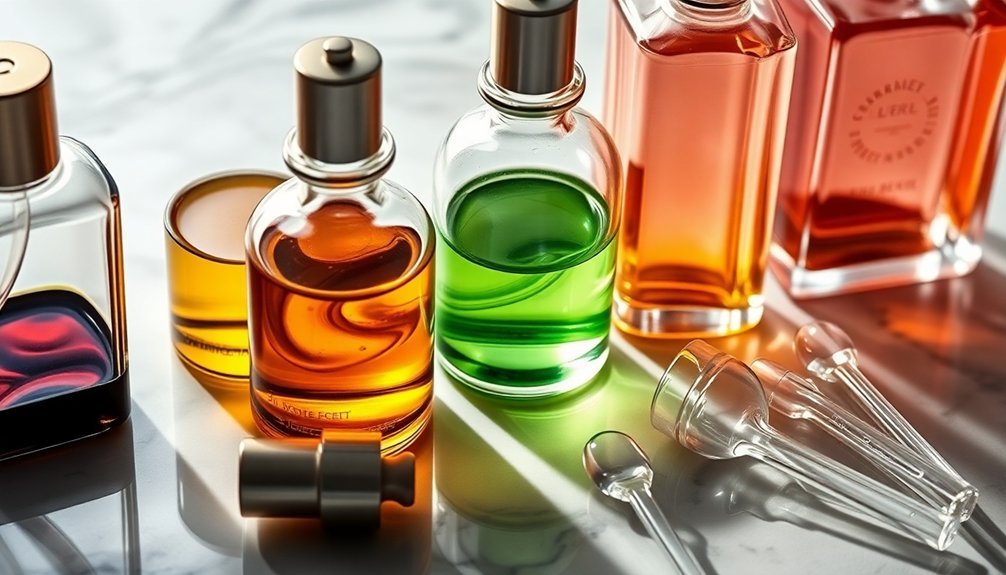
Four main concentrations define the strength and longevity of perfume oils: Eau de Cologne, Eau de Toilette, Eau de Parfum, and Parfum.
You'll find Eau de Cologne at the lightest end, containing just 2-5% perfume oil. It's perfect for summer wear but only lasts 1-2 hours. Proper application to pulsepoints will help maximize even these lighter concentrations.
Moving up, Eau de Toilette contains 5-15% oil and offers a balanced 2-3 hour wear time, making it ideal for daily use.
For longer-lasting scents, choose Eau de Parfum with 15-20% oil concentration, giving you 4-6 hours of wear.
At the highest end, you'll find Parfum, containing 20-40% oil. While it comes in smaller bottles, it delivers the most intense scent and can last up to 8 hours, justifying its higher price point.
Essential Tools for Dilution Success
When starting on perfume oil dilution, you'll need several essential tools to guarantee precise measurements and professional results. A digital scale accurate to 0.01g will ensure you achieve the right concentrations, while a beaker and glass stirrer help create uniform mixtures.
You'll also want disposable pipettes for transferring precise amounts of liquid. Perfumer's alcohol is crucial as a primary dilution base for creating spray perfumes.
For the filtration and storage phase, you'll need funnels, filters, and amber glass bottles that protect your perfume from light exposure during maceration.
If you're working with thicker materials, a water bath or electric wax melter can help warm them for easier mixing.
Don't forget small tools like droppers and weighing nets that make the process more manageable.
These tools will assist you in creating consistently high-quality dilutions every time.
Selecting the Right Base Solutions
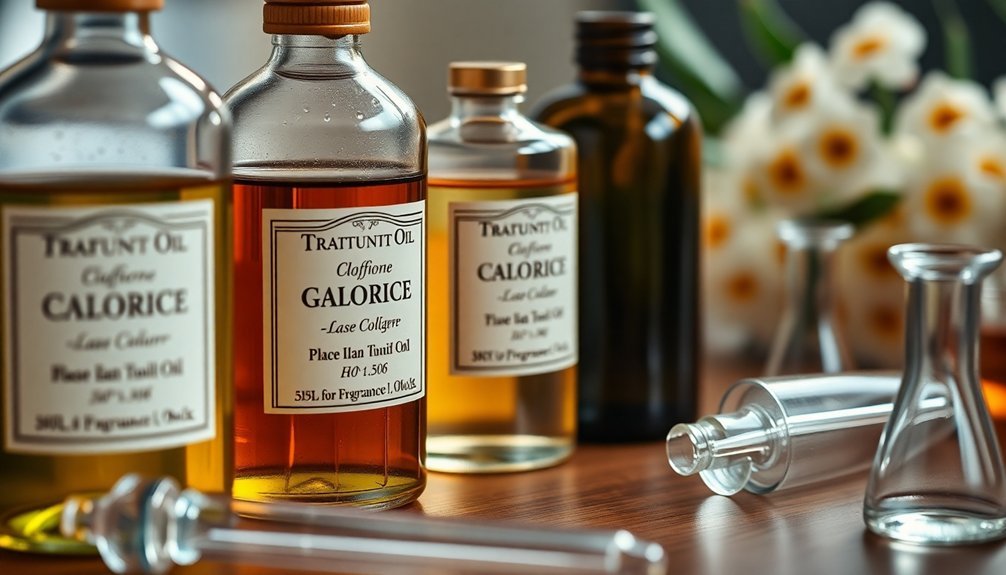
Choosing the right base solution forms the foundation of successful perfume oil dilution. You'll find three main options: alcohol-based solutions, water-based solutions, and carrier oils. For alcohol bases, you'll want to use 190-proof ethanol at about 70% of your mixture. When working with water bases, you'll need solubilizers to prevent separation, typically in ratios between 1:1 and 5:1. Selecting water-based formulations with proper solubilizers helps ensure your fragrance remains more stable over time.
| Base Type | Best For | Considerations |
|---|---|---|
| Alcohol | Traditional perfumes | High purity needed |
| Water | Body sprays, toners | Must use solubilizers |
| Carrier Oils | Skin-safe applications | 10-20% dilution rate |
For enhanced stability, consider combining solubilizers with solvents like 1,3 Propanediol, especially when working with challenging ingredients like citrus oils. This approach helps you achieve better clarity and longevity in your final product.
Calculating Perfect Dilution Ratios
After selecting your base solution, mastering the mathematics of dilution becomes your next key focus.
You'll need to understand that 20 drops equal one milliliter when using a glass dropper, which serves as your foundation for calculations.
For perfumes, you can work with concentrations between 20-80% essential oils, but you'll want to adjust based on your specific fragrance goals.
To calculate your ratio, multiply your total volume by your desired percentage. For example, if you're making a 10ml perfume at 40% concentration, you'll need 4ml of your fragrance oils.
Remember to keep safety in mind – while perfumes can handle higher concentrations, they're applied sparingly to specific areas.
Always document your measurements and use proper tools for accurate results.
Step-by-Step Mixing Process
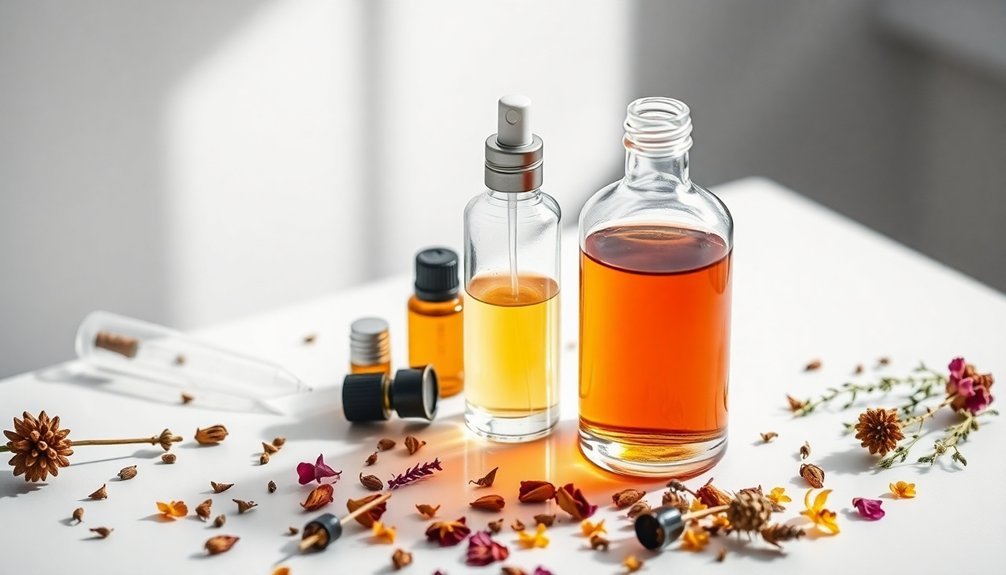
You'll want to start by gathering your chosen base oils and placing them in a clean container on your calibrated scale.
Next, carefully measure your essential oils according to your predetermined ratios, using precise measurements rather than drops for accuracy.
Finally, blend your oils together with gentle stirring motions and test small amounts on your skin to evaluate the fragrance's development.
Prepare Your Base Oils
The delicate art of mixing perfume oils begins with proper base preparation.
You'll want to select a carrier oil that complements your fragrance without overpowering it. Jojoba oil stands out as an excellent choice due to its stability and skin-friendly properties, while sweet almond and fractionated coconut oil offer lightweight alternatives.
Before mixing, gather your chosen carrier oil and verify you have a clean, dark glass container ready for storage.
You'll need to determine your dilution ratio based on your intended use – aim for 1-3% fragrance oil for personal care products, or 0.5-1% for room sprays. If you're working with synthetic fragrances, you can go higher, up to 10-20%.
Remember to use weight-based measurements for precise dilution and always perform a patch test before full application.
Measuring Essential Oil Ratios
With your base oils prepared, measuring precise ratios becomes your next focus for creating a balanced perfume.
Start by deciding your perfume's strength – a light perfume typically contains 20% fragrance oils and 80% carrier oil. For a 5ml bottle, you'll need 100 total drops.
Follow the 2:1:1 ratio for your fragrance components: use 10 drops of base notes (like sandalwood or vanilla), 5 drops of heart notes (such as jasmine or rose), and 5 drops of head notes (like citrus).
Add these in sequence, starting with base notes. The remaining 80 drops will be your carrier oil.
You can adjust these ratios based on your oils' potency and desired scent profile, but always maintain safe dilution levels between 0.5% to 2% for essential oils.
Blend and Test Carefully
Once you've gathered your materials and ratios, successful perfume blending requires methodical attention to detail and patience.
Start by creating your perfume's heart using two or three main ingredients in equal proportions, then adjust until you achieve your desired scent.
Add modifiers one at a time, using clean droppers for precise measurements. You'll want to smell the blend after each addition to avoid overdoing it.
Don't rush to add too many ingredients – this can make your fragrance unnecessarily complex. Include blenders to smooth transitions between different notes, and document each step of your process.
Finally, incorporate fixatives drop by drop to enhance the perfume's longevity.
Let your creation mature for at least a week, allowing the scents to meld together naturally. Test the final result and make any needed adjustments.
Safety Guidelines for Dilution
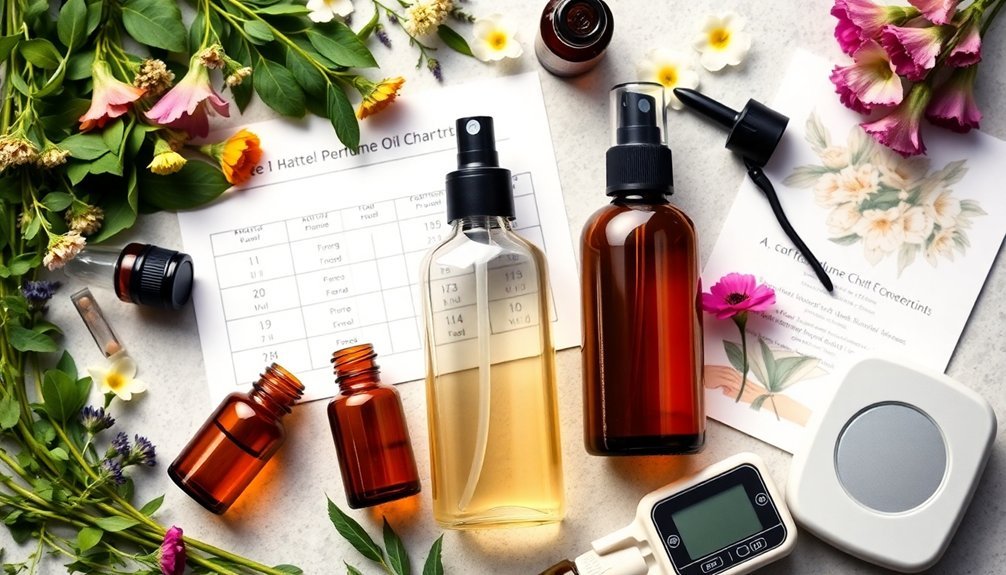
Because fragrance oils can cause severe skin reactions when used undiluted, following proper safety guidelines during dilution is essential for creating safe, wearable perfumes.
You'll need to stick to recommended dilution ratios: 10-20% for eau de parfum, 5-10% for eau de toilette, and 3-8% for eau de cologne.
Before using any new fragrance oil, conduct a patch test to check for allergic reactions.
When handling concentrated oils, keep water nearby in case of spills, and immediately flush your skin if contact occurs.
Don't forget to check expiration dates and discard any oils that smell off.
Always use high-quality, therapeutic-grade essential oils from trusted sources, and remember that different products require specific dilution rates.
If you're working with alcohol-based perfumes, be aware that high concentrations can cause skin dryness and irritation.
Common Carrier Options Explained
Selecting the right carrier for your perfume creates the foundation for a successful fragrance blend.
You'll find three primary carrier oils that excel in perfumery: jojoba, sweet almond, and fractionated coconut oil.
Jojoba oil mimics your skin's natural oils, offering excellent absorption and stability. It's perfect for extending your perfume's shelf life and wear time.
Sweet almond oil provides a gentle base for sensitive skin while promoting subtle scent profiles.
Fractionated coconut oil stays liquid at all temperatures and creates a non-greasy finish.
For spray perfumes, you'll want to take into account perfumer's alcohol. It helps disperse and evaporate fragrances effectively, creating that initial burst of scent.
You can dilute your oils with alcohol at ratios between 10:90% and 40:60%, depending on your desired strength.
Preserving Scent Strength
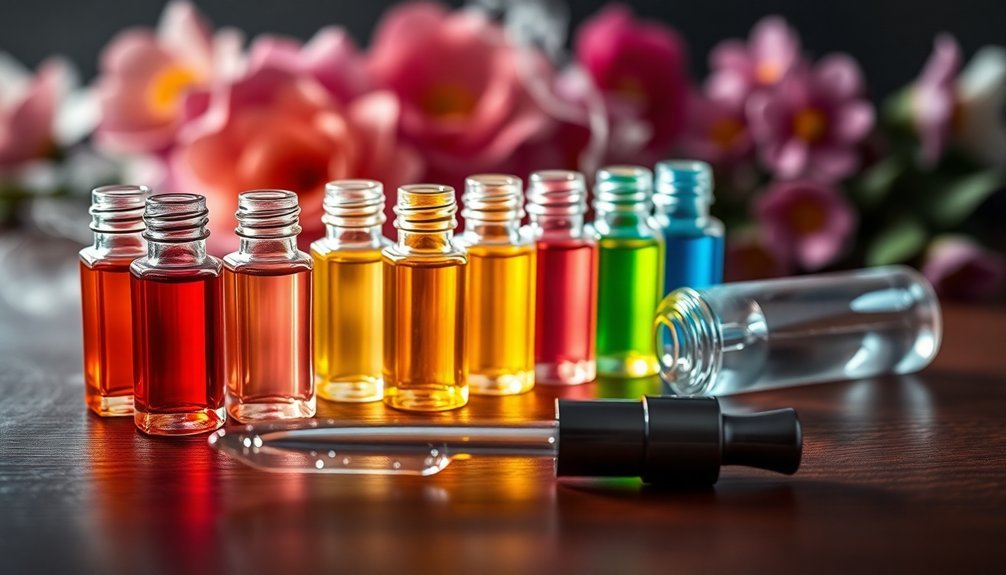
After choosing your carriers and creating your perfect blend, proper storage becomes the next key to maintaining your perfume's potency.
Store your perfume oils in a cool, dark place where temperatures stay between 15-21°C (60-70°F). Keep them away from bathrooms, heaters, and direct sunlight.
You'll want to use dark-colored or opaque glass bottles with tight-fitting screw-top caps to protect your oils from UV rays and minimize air exposure.
Don't leave bottles open longer than necessary, as oxygen can cause your fragrance to deteriorate. To extend shelf life, consider transferring oils to smaller containers to reduce the air space above the liquid.
Remember that temperature fluctuations can lead to leaks and contamination, so finding a stable storage spot is essential for preserving your perfume's strength and character.
Troubleshooting Dilution Issues
When you're working with perfume dilutions, you'll encounter common issues like incorrect measurements, separation of materials, and overwhelming scent strengths.
If you notice your materials separating, try gently warming the mixture in a water bath while stirring, or consider using a different diluent that's more compatible with your ingredients.
You can fix overly strong concentrations by further diluting with your chosen medium, but remember to use a scale rather than drops for precise measurements.
Common Concentration Mistakes
Although perfume oil dilution may seem straightforward, several common mistakes can derail your fragrance creation process.
You'll often find that over-concentrating fragrance oils leads to overwhelming scents and potential skin irritation, while choosing the wrong dilution medium can mask your fragrance's true character.
Using inaccurate measurement techniques, like counting drops instead of weighing materials, can result in inconsistent and unreliable results.
- Picture yourself carefully measuring 3% essential oil into perfumer's alcohol using a precise scale, rather than eyeballing drops.
- Imagine testing your diluted fragrance on a small patch of skin and discovering it needs further adjustment.
- Visualize gradually adding carrier oil in small increments until you achieve the perfect balance, rather than dumping in too much at once.
Fixing Separation Problems
Separating perfume oils can quickly ruin your fragrance creation, but you'll find most separation issues are easily fixable with the right approach.
First, check your dilution ratios – if you've used more than 10% essential oils, reduce the concentration. Then, verify you're using the right solvent like perfumer's alcohol rather than carrier oils.
If you notice separation after mixing, gently shake the bottle to reincorporate the ingredients. For persistent issues, try pre-diluting thick or resinous oils before adding them to your main mixture. You can also heat these materials slightly to make them more manageable.
Remember to store your perfumes in a cool, dark place to prevent temperature-related separation. If problems continue, consider adding a stabilizer or adjusting your solvent ratio for better stability.
Adjusting Scent Strength
Getting your perfume's scent strength just right can be tricky, but you'll find several reliable methods to adjust the concentration. Start with a conservative approach by diluting your oils in perfumer's alcohol at a 10% ratio, then test the result. If needed, you can increase or decrease the concentration based on your preference.
- Visualize adding just 3-4 drops of your oil blend to pulse points – if this feels too weak, increase the concentration.
- Picture yourself walking through a gentle cloud of fragrance that lingers for 2-3 hours – this indicates ideal strength.
- Imagine someone needing to lean in close to smell your perfume, rather than detecting it from across the room.
For stronger scents, consider using Eau de Parfum concentrations, while Eau de Toilette works well for lighter, daytime wear.
Storage and Shelf Life Tips
To maximize the longevity of your fragrance oils, proper storage plays a crucial role. Store your oils in a cool, dry area with temperatures between 65°F and 85°F, away from direct sunlight and extreme temperature fluctuations.
Always use dark amber or cobalt glass bottles to protect your oils from UV rays. When your bottle is half empty, transfer the remaining oil to a smaller container to reduce oxidation.
Make sure you're sealing bottles tightly and labeling them with essential information, including the opening date.
You'll want to regularly check your stored oils for signs of degradation. While fragrance oils typically last 1-2 years, proper storage can extend their shelf life.
If you're making perfume sprays with essential oils and carriers, expect them to last about 6 months when stored correctly.
Frequently Asked Questions
Can I Use Vodka Instead of Perfumer's Alcohol for Diluting Oils?
You shouldn't use vodka to dilute oils – it contains too much water and won't dissolve oils properly. Instead, you'll want to use high-proof alternatives like Everclear, Club 190, or perfumer's alcohol.
Why Do Some Perfume Oils Become Cloudy After Dilution?
Your perfume oils become cloudy when water-insoluble ingredients don't mix well with the diluting solution. Temperature changes, improper storage, and the absence of solubilizers can also cause this cloudy appearance in your mixture.
How Long Should Perfume Oils Mature Before Diluting?
You'll need to let your perfume oils mature for at least 48 hours, though complex blends may require 2-4 weeks. For the best results, allow resinous materials to mature for up to a month.
Does Temperature Affect the Dilution Process of Perfume Oils?
Yes, temperature greatly affects your perfume oil dilution. You'll achieve better results at lower temperatures (0°C to -15°C), as it helps control solubility and speeds up precipitation, making your dilution process more efficient.
Can I Mix Different Brands of Perfume Oils Together?
Yes, you can mix different brands of perfume oils together. You'll want to test small amounts first and understand each oil's scent notes to create harmonious blends that complement each other.
In Summary
Now you're ready to transform your perfume oils into wearable sprays with confidence. Remember to start with small test batches and adjust concentrations until you find your perfect blend. Keep detailed notes of your successful ratios, store your creations properly, and don't forget to label everything clearly. With practice, you'll master the art of dilution and create unique, long-lasting fragrances that perfectly suit your style.





Leave a Reply